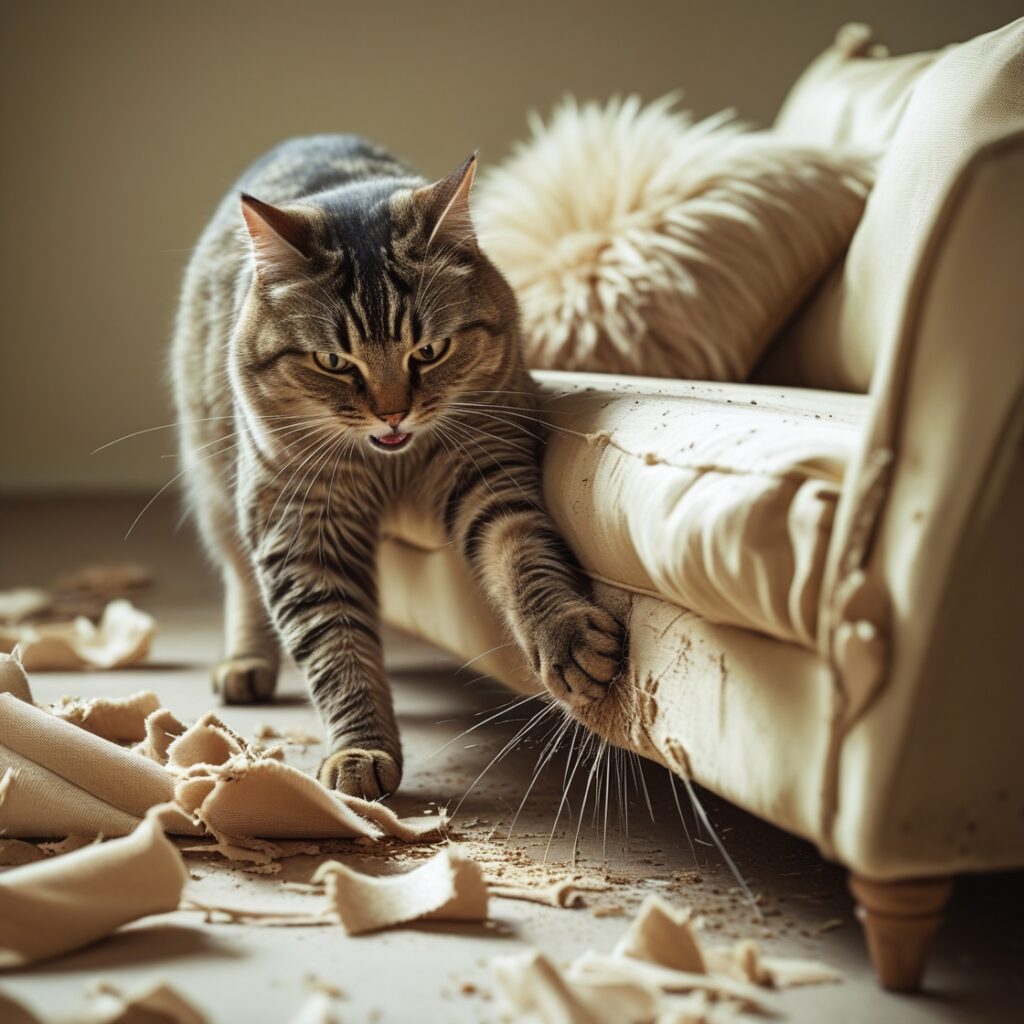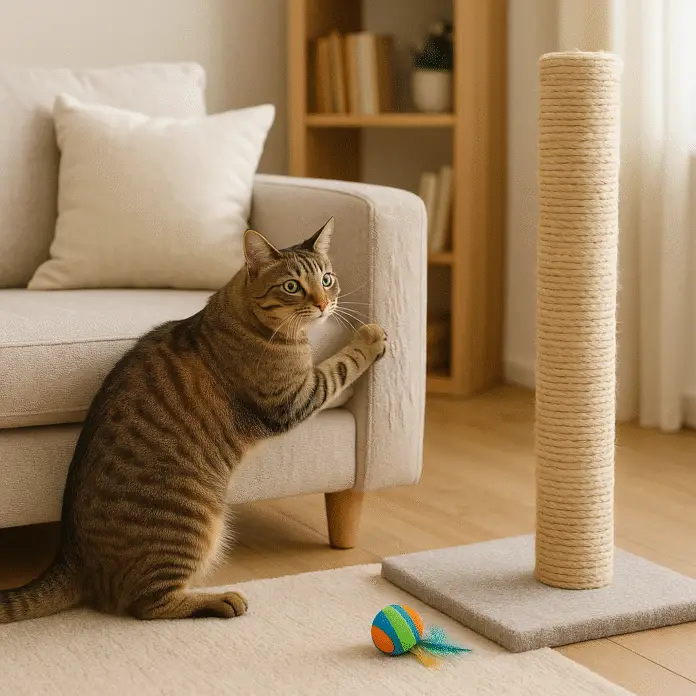If your cat is making your furniture his personal scratching place, then you’re not unique- a lot of cat owners experience that. Cats’ natural behavior cannot be denied. It is very necessary for the feline form, but it can cost you a lot when your pet decides to turn your home into his scratching playground. Yet, it is good to know that there are many good ways that can help you stop a cat from scratching furniture and meanwhile you will keep your cat healthy and happy.
🐾 Why Do Cats Scratch in the First Place?

Prior to figuring out the problem, it is of paramount importance to realize what the roots of the obsession are in the first place. Scratching is not a question of discipline. It is a behavior that is part of the animal. It also involves the following functions:
- Claw Maintenance: Scratching gets rid of the outworn upper layer of a claw and keeps it sharp and healthy.
- Territorial Marking: Cats’ paws have scent glands. The scratching process leaves a clear sign both scent and visual to take the territory of a cat.
- Exercise and Stretching: The movement brings a comfortable extension and at the same time, the muscular tension in the back and shoulders is maintained.
- Stress Relief: Anonymous animals deal with tension and excitement by scratching and biting.
Once the causes are clear, it is easier to pick out different and available cat scratching solutions.
🔨 Step-by-Step Fixes to Stop Destructive Scratching
1. Present Hard to Resist Scratching Alternatives
One of the most proven methods of cat scratching prevention at home is by coming out with more attractive scratching posts and pads.

Here are the Scratchers to Use:
- Vertical Posts: Choose posts that are tall, strong, and are primarily made of sisal rope.
- Horizontal Boards: Easy for cats who like to scratch low and long.
- Inclined Scratchers: Offer a mixture of up-and-down and sideways movement.
- Cat Trees: Multi-functional structures with areas for scratching, climbing, and resting.
How to Proceed:
- Place the scratchers next to the areas where your cat is currently scratching.
- Sprinkle some catnip/pheromone spray on the posts.
- Have the cat follow a toy to the scratcher.
2. Convince Cats that Furniture is Not a Nice Place to Scratch
While you are increasing the attractiveness of the scratchers, ensure that you make your furniture repulsive to your cat to scratch.

Practical Repellents:
- Double-Sided Tape: The majority of cats dislike adhesive surfaces.
- Plastic Furniture Guards: They are almost invisible and work perfectly well without making your furniture look unattractive.
- Aluminum Foil or Sandpaper Strips: These are some materials that are not liked by most of the cats to scratch.
- Cat-Safe Citrus Spray: One of the reasons most cats don’t like citrus is the smell.
3. Cut Cat’s Claws Regularly
Keeping your cat’s nails short is essential to prevent scratching damage and noise. A good rule of thumb is to cut your pet’s nails every two to three weeks. However, in the case where your cat is not giving a hand, think about the following:
- Fit Soft Nail Caps: It’s the quite easy method to cover the nails so that sharp objects can’t be exposed to cause damage.
- Professional Grooming: Vets or groomers are professionals that do the job quickly and efficiently without causing any harm to the pet.
🧠 Behavioral Training Techniques
If you really want to, it is possible to train even a cat to behave, by using patient guidance and suitable methods that will shape their habits into better ones.
1. Use Positive Reinforcement
Rather than scolding your cat, reward good behavior.

- If your cat uses a scratching post, give it a treat.
- Cats can respond to an affectionate tone and attention.
- Engage yourself near the scratcher to form the cat’s positive associations.
2. Try Clicker Training
With a consistent attitude, the clicker can be the savior of the situation.
- Use the clicker the moment your cat uses the post.
- At the moment of using the scratching post, give it a treat.
- Do the above consistently to reinforce the behavior.
3. Redirection Is Key
Instead of punishing your cat for scratching off-limits, direct its attention to the scratcher.
- Just say “no” firmly.
- In a very polite manner, pick the cat up.
- Place it near the scratcher and encourage it to use it.
Regular gentle correction and gentleness are the foundation of long-term success.
🧨 Addressing Emotional or Environmental Triggers
When cats are stressed, they might have the tendency to scratch the objects more frequently. The emotional cause of the problem is as important as the removal of physical triggers.
Common Triggers for Excessive Scratching:
- New Pets or People in the Home
- Changes in Routine
- Boredom or Lack of Stimulation
Stress-Relief Solutions:

- Pheromone Diffusers: Synthetic feline facial pheromones can help calm your cat.
❌ The Inhumanity of Declawing
Some individuals may consider declawing as a simple solution, but many are unaware of its huge downsides. It entails chopping off the terminal bone in each toe and can cause the following:
- Persistent painful sensations
- Violation of the box
- Attack of the self
- Arthritic or Mobility Issues
A lot of the countries and a number of the U.S. states have already outlawed declawing on ethical grounds. Concentrate on more secure, efficient, and cat-friendly alternatives.
📌 Regularity and Discipline = Winning
Getting rid of ill scratching practices does not magically or rapidly happen. The primary reasons for implementing changes are as follows:
- Giving other options.
- Positive reinforcement of the good behavior.
- Reducing or eliminating triggers.
- Sticking to your method of approach kindness and constancy.
And always bear in mind that your cat is not a villain and not a bad-hearted creature; hence, it is not the source of improper behavior. Scratching is the basic right of a cat to exhibit its natural instincts. Moreover, providing the right direction will be beneficial for the bonding and welfare of you later.




Thanks for every one of your hard work on this site. My mom really loves doing investigation and it is simple to grasp why. I know all about the dynamic medium you convey very important tips via your web site and as well as encourage response from other ones on the concern while our own girl is without question starting to learn a lot of things. Enjoy the remaining portion of the year. You’re performing a fabulous job.